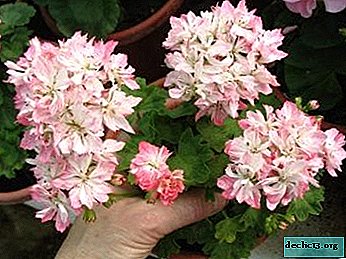Useful tips for breeding and growing Griffin begonias at home. Flower photo

Begonia is an amazing flower that conquers gardeners with its incredible shape and colorful petals.
This plant can be found in almost every home. There are more than 900 full and 2000 hybrid species of this flower.
But today we look at one of the last bred hybrids - the Griffin begonia. You will learn how to care for her, how she looks, what are the ways of reproduction.
Characteristic
Griffin begonia comes from one of the most popular species of this plant - the Royal begonia. This Queen Mother gave rise to most of the hybrids of this flower..
History of occurrence
For the first time, the Royal begonia was discovered at an auction in London in 1856 among Asian orchids. And in 1859 the first three hybrids were already bred. After that, active work began on the cultivation of new varieties and varieties of this plant. The material for crossing was mainly yellow, Chinese, and powerful begonias.
Over the entire period of the history of breeding the Royal begonia, their numerous varieties were crossed, which differ in color and shape of the leaves. The last of these hybrids is the Griffin. It is more versatile for growing at home, because it is less whimsical.
External features of the flower
Begonia griffin is a strong and durable decorative leaf flower, attracting a lot of attention as a perennial culture - at home in a pot, and as an annual - in the garden.
The name of this plant comes from its structure: lush large leaves in shape resemble an open paw of a griffin of black-green color with a silver pattern. This culture will bring comfort to your apartment. Against the background of dark leaves of begonia, bright green plants will sparkle with new colors.
A griffin can grow to a height of 41 centimeters. Experienced growers recommend cultivating this type of begonia in a container culture, taking it to the garden in the summer, and cleaning the house in winter.
IMPORTANT! This type of begonia is stress-resistant to external adverse conditions. It is not picky about watering and soil, and is also much simpler in agricultural technology, in comparison with other hybrids.Photo
Get to know this beautiful flower in the photo.:




Growing at home
Begonia Griffin, like other plants, requires attention and care. She needs timely watering and top dressing. She loves the sun, especially during flowering, and high humidity. This is because the begonia originally grew in the tropics.
In general, begonia care is not complicated. The most important thing to remember is a few basic rules for care: maintaining the optimum temperature, good lighting, which will help the flower to blossom its lush flowers.
Basic rules and methods of landing
Any species and forms of begonias are planted either with tubers or seeds (read about tuberous begonias here). The most popular method is planting tubers, as it is less labor intensive, but effective.
With this type of planting, you need to get the tubers out of the ground, thoroughly clean and trim the stems. After that, the processed tubers are stored all winter in peat, while the storage temperature should be maintained at +8 - +10 degrees. The period of planting tubers in the soil lasts from February to May.
Tuber germination occurs in small potsthat are filled with sandy ground. Remember that tubers only sink halfway into the ground. At this time, they require moderate watering. After a couple of weeks, the tubers sprout, roots and shoots appear. Once they fully germinate, the tubers should be sprinkled with earth and put the pot in a well-lit place.
Planting begonias with the help of seeds is a more complicated process that requires due attention, since for the seeds it is necessary to prepare the soil mixture in advance from sheet soil, sand and peat. And also seeds can be germinated in peat.
Since begonia seeds are quite small, so do not bury them in the ground. Experienced gardeners gently sow them on the ground and press down a little with their fingers. Two weeks later they germinate.
ATTENTION! It is necessary to transplant the grown begonia into a pot with an earthen lump!The third way of planting, cuttings, also has its own nuances. To create a leaf stalk, you need to take a leaf about 5 centimeters long, but no less. This instill the stalk so that the leaf does not touch the ground. The soil around is crushed and watered.
Lighting and location
 The plant loves a lot of diffused light. This is due to the fact that under natural conditions it belongs to the lower row of flora, which is covered with tree crowns.
The plant loves a lot of diffused light. This is due to the fact that under natural conditions it belongs to the lower row of flora, which is covered with tree crowns.
Griffins do not like direct sunlight. With one such hit, the saturated color of the leaves begins to fade, and the foliage dries.
It is better to place flower pots at home on shelves or a table in front of a light source, create a small shadow with the help of curtains. Window sills are better to be excluded from the list of favorable places for begonias..
In a tropical climate, where begonias are used to growing, the sun is always at its zenith, so the plants have not learned to turn to light as in the latitudes of a temperate climate. Based on this, flower growers do not recommend rearranging flower pots from one place to another.
The soil
Special soil requirements are explained by the structure of the root system. Since begonia rhizome is located on the surface from which thin fibrous roots extend, it is necessary to choose a breathable substrate. This will help the plant to get more moisture and nutrition.
Peat-based soil mix is a great option.. It has favorable weak acidity for the Griffin. Humus, leaf soil or baking powder in a ratio of 1: 3 can be added to peat.
Care
As mentioned earlier, the Griffin is a hybrid of the Royal begonia. In fact, it is considered a plant unpretentious to living conditions. However, he also needs to create a number of special conditions. How to organize care for the Royal begonia, read here.
Watering
The flower loves a moist substrate, but not too wet. And also it can not be overdried. Experienced gardeners recommend watering the plant when the substrate is dry to a third of the depth. In the winter season, watering is reduced, or water is poured into a pan so that the roots can independently regulate fluid intake.
TIP! If you dried the substrate to the state that it began to lag behind the walls of the pot, you must immerse the bowl in water a little above room temperature for 20 minutes.Air humidity
Due to the lush large leaves, the plant has a huge area of liquid evaporation. The roots do not have time to compensate for such a rapid loss of moisture, so humidification is an important indicator in the care of the Griffin.
There are several ways to help maintain optimal humidity around 50-60%:
- installation of a household air humidifier;
- regular humidification of the air around the flower with a spray gun;
- in the warm season, placing pots in trays with moistened pebbles or expanded clay.
Top dressing
 The griffin, as a hybrid of the Royal begonia, needs a constant supply of nutrients. Once a month, the flower needs to be fed with organic or mineral fertilizers. Remember, you cannot fertilize a plant with dry soil.. This is fraught with burns and death of the roots. Therefore, before each dressing, you must first water the plant.
The griffin, as a hybrid of the Royal begonia, needs a constant supply of nutrients. Once a month, the flower needs to be fed with organic or mineral fertilizers. Remember, you cannot fertilize a plant with dry soil.. This is fraught with burns and death of the roots. Therefore, before each dressing, you must first water the plant.
Also, during the growth of begonia, complex top dressing is required with the content of nitrogen, phosphorus and potassium in equal proportions. And in the summer, to stimulate the formation of new roots, it is recommended to fertilize with mixtures with the prevalence of phosphorus.
Diseases and Pests
The diseases of this flower include:
- Powdery mildew (white coating on the surface of the leaves. Treatment - treatment with an aqueous solution of fugnicide type "Topaz").
- Gray rot (affects the leaves and stalk. Treatment - treatment with a one percent solution of Bordeaux mixture or 0.2% “Fundazol”).
- Ring spotting (yellowish-green spots on the leaves. It is recommended to remove the flower separately for the safety of other plants, since this virus is carried by thrips and aphids).
- Bacterial spotting (watery blisters that turn brown over time, affecting leaves and flowers. Treatment is the elimination of an infected plant and the prophylactic treatment of other flowers with a half-percent solution of copper chloroxide once every two weeks).
- Soft pseudo-shield (dark sugary secretions, mushroom coating on the surface. Treatment - treatment with garlic infusion or a mixture of pyrethrum per 100 grams per 10 liters of water twice a month).
Breeding
The griffin, like any other royal begonia hybrid, propagates vegetatively: leafy cuttings or dividing rhizomes.
Rooting a leaf fragment
The large leaf blade is divided into segments so that each has a thick vein. She will give the baby. Loose soil for planting. It is pre-watered and poured into a transparent glass. Plant a leaf and place it in a greenhouse.
As soon as a new sprout appears, the cup is taken out of the greenhouse and the flower is grown as an ordinary houseplant.
Transfer
Griffin is not afraid of transplantation. If at the same time it is necessary to rejuvenate the flower, the lower leaves are cut off, part of the root system is cut off and the rhizome is deepened by a few centimeters. Each next pot you need to choose a little more by 1.5 centimeters.
Begonia is a plant that has won the hearts of many gardeners. Griffin is one of the last crossed hybrids. It is most suitable for growing at home, because it is less whimsical in its environment.

















